HumanChromosomes Learning Objectives
After completing this chapter, you will be able to:
- Recognize chromosomes as carriers of heredity,
- Explain the structure of a human chromosome;
- Differentiate between sex chromosomes and autosomes;
- Describe the functions of chromosomes.
You have already studied in the previous chapter about the behaviour of chromosomes during cell division. You have also studied that chromosomes are hereditary vehicles on which genes are located. In this chapter, you will study about the structure and functions of human chromosomes.
Chromosomes – The Carriers Of Heredity
- A chromosome (Gk. chroma: colour; soma: body) is a strand of deoxyribonucleic acid (DNA) molecule associated with proteins found in the nucleus of a cell. The chromosomes contain genes, thus, they serve as the carriers of heredity.
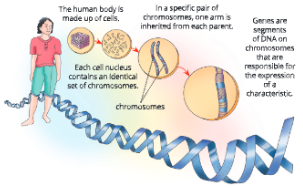
- The chromosomes are hereditary vehicles. The characteristics move from parents to the offspring in the form of genes located on the chromosomes.
- The genes are composed of DNA and proteins. DNA functions as the genetic material and forms the chemical basis of heredity.
- A gene is a segment of DNA that codes for the synthesis of a specific protein, which controls the expression of a particular characteristic in an individual. A gene is the basic unit of heredity found on a chromosome.
Number of chromosomes in an individual
- The number of chromosomes is constant for all individuals in a species and an individual has a fixed and equal number of chromosomes. The number of chromosomes in the somatic cells (body cells) of higher plants and animals is in diploid number represented by 2n (both sets of homologous chromosomes present).
- In gametes (sperm and egg), it is in haploid number and is represented by n.
The chromosome number of some plants and animals is given in Table.
- A human body cell has 46 chromosomes. These 46 chromosomes are arranged into 23 pairs of homologous chromosomes.
- We inherit half our chromosomes from our mother and a half from our father. Thus, we inherit 23 unpaired chromosomes from each parent.
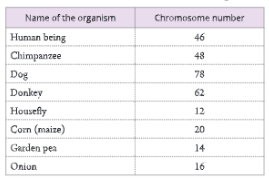
Structure of chromosomes
- A chromosome is a diffuse, thread-like structure within the nucleus of a cell.
- At the time of cell division, chromosomes condense and become visible under the microscope.
- At the start of cell division, a chromosome consists of two chromatids joined at some point along the length. At the point of joining, a constriction is formed, called a centromere.
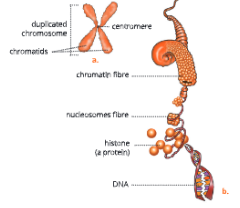
- The spindle fibres are also attached to the centromere at the time of cell division. These spindle fibres contract and help in the separation of two sister chromatids towards the opposite poles in a dividing cell.
- On the completion of cell division, these chromatids become chromosomes. These chromatids decondense and form very thin thread-like chromatin fibres. Each chromatin fibre is made up of DNA and histone proteins with a small amount of RNA.
Chromatin fibre
- Chromatin is the complex of DNA and proteins found in the nucleus. The chromatin material largely consists of two strands of DNA and proteins (mainly histones). DNA forms about 40% while histones form about 60% of the overall part of the chromosome.
- DNA has negative charges along its length while histones are positively-charged basic protein molecules which are bound to it.
- This DNA-histone (protein) complex is called chromatin. It has been shown that the DNA helix combines with groups of eight histone molecules to form a structure known as a nucleosome. It has the appearance of beads on a string. In a human cell, there are about two million nucleosomes among 46 chromosomes.
Structure of DNA molecule
- Rosalind Franklin for the first time in 1953 studied the shape of the DNA molecule. Then, Watson and Crick in 1953 worked out the structure of DNA. Watson and Crick showed that DNA is a large molecule (macro-molecule) consisting of two polynucleotide strands, complementary in nature, wound around each other in a double helix.
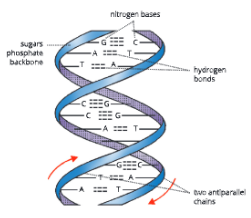
- The strands run in opposite directions, i.e. they are antiparallel. Each single DNA strand is composed of repeating nucleotides. Nucleotides are made of three components, a phosphate, a sugar (pentose) arranged lengthwise and a nitrogenous base attached to the sugar inwards.
- The sugar-phosphate backbone has nitrogenous bases arranged at right angles giving a ladder-like arrangement. There are two purine bases and two pyrimidine bases.
- The bases are guanine (G), thymine (T), adenine (A) and cytosine (C). Among them, adenine and guanine are purine bases and thymine and cytosine are pyrimidine bases. The guanine is complementary to cytosine and thymine to adenine.
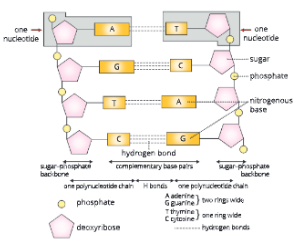
Chromosome
- A thread-like strand of DNA and protein present in the nucleus of a cell. They carry genes, the carrier of heredity.
Chromatid
- One of the two thread-like strands of a chromosome formed as a result of cell division. Each chromatid contains a double helix of DNA,
Chromatin
- A complex of DNA and protein found in the nucleus of a cell. A chromosome is packaged and organised into chromatin.
How are new DNA strands formed?
- Formation of a new DNA molecule is called DNA replication. During replication, DNA double helix opens at one end, freeing the strands.
- For each of these free strands, new complementary strands begin to form in the opposite direction. This process takes place for the whole length of DNA as given in.
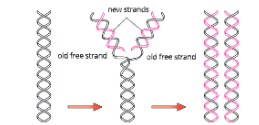
- DNA double helix
- Two strands of DNA double helix open at one day. A new strand is produced against each simultaneously
- Each new DNA contains one original (old) strand and one new strand
Types of chromosomes
- The chromosomes may differ in the position of the centromere. Centromere is the point on the chromosome, marked by a constriction where nitrogenous sister chromatids are attached during cell division.
- base If the centromere is near the middle, the chromosome is metacentric. If the centromere is towards one end (away from the centre), the chromosome is acrocentric. If the centromere is located at the end, the chromosome is telocentric.

- In addition to a centromere, there may also be a secondary constriction on a particular chromosome. The part of the chromosome located distal to (far from) a secondary constriction is called a chromosome satellite.
Sex chromosomes and autosomes
- In human beings, out of the 23 pairs of chromosomes, a specific pair, i.e. the 23rd pair of chromosomes, determine the sex of the individual. These are called sex chromosomes or allosomes. All other 22 pairs of chromosomes are termed autosomal chromosomes or autosomes.
- The autosomes carry genes that control somatic traits and play no role in sex determination. The two members of each pair of homologous autosomes are similar in size and shape, but this may not be true for the sex chromosomes.
- In human males, one sex chromosome is smaller than the other. The larger one is known as X chromosome and the smaller one as the Y chromosome. Thus, the condition in the male may be briefly expressed as XY and in female as XX.
- The sex chromosomes of human females are described as homomorphic and that of human males as heteromorphic. The human females produce only one type of gametes (all with X) and are said to be homogametic. The human males produce two types of gametes (X type and Y type) and are described as heterogametic.
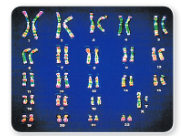 Human karyotype – Human somatic cells have 22 pairs of autosomes and 1 pair of sex chromosomes (XX or XY); Chromosomes are paired by matching their banding pattern and are arranged by size and shape.
Human karyotype – Human somatic cells have 22 pairs of autosomes and 1 pair of sex chromosomes (XX or XY); Chromosomes are paired by matching their banding pattern and are arranged by size and shape.
Functions of chromosomes
- Chromosomes are hereditary vehicles that contain genes. All the hereditary information is located on the genes.
- Chromosomes control the synthesis of structural proteins and thus help in cell division, cell repair and cell growth.
- By directing the synthesis of enzymatic proteins, chromosomes control cell metabolism.
- Chromosomes guide development and control cell differentiation.
- Sex chromosomes (XX and XY chromosomes) determine the sex of individuals.
What is a gene?
- A gene is a basic unit of heredity or inheritance of a character passed from parents to offspring via chromosomes.
- A gene is a segment of DNA on a chromosome that encodes a particular protein which is expressed in the form of a particular characteristic of the body.
- Genes are located on specific positions (loci) on the chromosomes.
- Genes are transmitted from parents to offspring through the gametes.
HumanChromosomes Summary
- A chromosome is a thread-like strand of DNA molecule associated with proteins found in nucleus. Chromosomes carry genes and are referred to as hereditary vehicles.
- Genes are located on chromosomes.
- The number of chromosomes is constant for a species. Human beings have 46 chromosomes.
- Depending upon the location of centromere, chromosomes can be metacentric, acrocentric and telocentric.
- DNA-histone complex in chromosomes is called chromatin.
- DNA molecule is a double-helical structure. Each single DNA strand is composed of repeating nucleotides.
- Formation of a new DNA molecule is called DNA replication.
- There are two kinds of chromosomes in human beings – sex chromosomes (chromosomes that decide the sex of an individual) and autosomes (rest of the chromosomes, somatic chromosomes are same in males and females).
